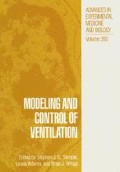Abstract
The carotid bodies (CBs) have been implicated in the kinetic control of ventilation (VE) during moderate exercise (reviewed in Refs. 10 & 11). That is, augmenting CB responsiveness (eg. by hypoxia or dietary-induced metabolic acidaemia) shortens the time constant of the VE response (τVE) to square-wave exercise forcings, while CB suppression (induced by hyperoxia, metabolic alkalaemia or intravenous dopamine infusion) or surgical CB resection is associated with a prolonged τVE.The present investigation considers the possibility that intra-breath oscillations of arterial PO2 (PaO2), PCO2 (PaCO2) and pH (pHa) may be involved in this CB modulation. Yamamoto (12) proposed that these oscillations, which have been measured in humans at rest and during exercise (1), could provide a component of respiratory control independent of their mean levels, mediated possibly via the rate of change of pHa in the falling phase of the oscillation (dpHa/dt↓) (3). The reflex efficacy of this humoral oscillation can be modulated by the “phase-coupling” (9) between the ensuing oscillation of CB discharge and the on-going respiratory cycle: stimuli presented to the CBs during inspiration evoke stimulation, while respiration is relatively unaffected (or may even be depressed) by stimuli arriving at the CBs during expiration (2–6). We therefore tested the following hypothesis: if, at exercise onset, the peaks of the oscillating CB discharge were to arrive at the brainstem respiratory integrating areas at a more optimal phase of the respiratory cycle than at rest (e.g., during inspiration, rather than expiration), then the kinetics of the exercise hyperpnoea would be faster compared to a situation where the phase coupling at exercise onset was unchanged or even became “pessimal” (4).
Access this chapter
Tax calculation will be finalised at checkout
Purchases are for personal use only
Preview
Unable to display preview. Download preview PDF.
Refences
Band, D.M., C.B. Wolff, J. Ward, G.M. Cochrane, and J.G. Prior. Respiratory oscillations in arterial carbon dioxide tension as a control signal in exercise. Nature 283: 84–85, 1980.
Black, A.M.S., and R.W. Torrance. Chemoreceptor effects in the respiratory cycle. J. Physiol. (Lond.)189: 59P–61P, 1967.
Cross, B.A., A. Davey, A. Guz, P.G. Katona, M. Maclean, K. Murphy, S.J.G. Semple, and R.P. Stidwell. The pH oscillations in arterial blood during exercise; a potential signal for the ventilatory response in the dog. J. Physiol. (Lond.) 329: 57–73, 1982.
Cunningham, D.J.C. Introductory remarks. Some problems in respiratory physiology. In:Modelling and Control of Breathing, edited by B.J. Whipp and D.M. Wiberg. New York: Elsevier, 1983, p. 3–19.
Cunningham D.J.C., P.A. Robbins, C.B. Wolff. Integration of respiratory responses to changes in alveolar partial pressures of CO2 and O2 and in arterial pH. In: Handbook of Physiology: The Respiratory System,vol. II, Control of Breathing, pt. 2, edited by N.S. Cherniack and J.G. Widdicombe. Bethesda: Am. Physiol. Soc., 1986, p. 475–528.
Eldridge, F.L. and T.G. Waldrop. Neural control of breathing. In: Pulmonary Physiology and Pathophysiology of Exercise, edited by B.J. Whipp and K. Wasserman. New York: Dekker, 1991, p. 309–370.
Jain, S.K., S. Subramanian, D.B. Julka, and A. Guz. Search for evidence of lung chemoreflexes in man: study of respiratory and circulatory effects of phenyldiguanide and lobeline. Clin. Sci. 42: 163–177, 1972.
Petersen, E.S., B.J. Whipp, D.B. Drysdale, and D.J.C. Cunningham. Testing a model. In: Control of Respiration During Sleep and Anesthesia, edited by R. Fitzgerald, S. Lahiri, and H. Gautier. New York: Plenum, 1978, p. 335–342.
Whipp, B.J. The control of exercise hyperpnea. In: The Regulation of Breathing, edited by T. Hornbein. New York: Dekker, 1981, p. 1069–1139.
Whipp, B.J. Peripheral chemoreceptor control of the exercise hyperpnea in humans. Med. Sci. Sports Ex.26: 337–347, 1994.
Whipp, B.J., and S.A. Ward. The coupling of ventilation to pulmonary gas exchange during exercise. In: Pulmonary Physiology and Pathophysiology of Exercise,edited by B.J. Whipp and K. Wasserman. New York: Dekker, New York, p. 271–307, 1991.
Yamamoto, W.S. Mathematical analysis of the time course of alveolar CO2. J. Appl. Physiol. 15: 215–219, 1960.
Author information
Authors and Affiliations
Editor information
Editors and Affiliations
Rights and permissions
Copyright information
© 1995 Springer Science+Business Media New York
About this chapter
Cite this chapter
Ward, S.A., Swain, L., Frye-Kryder, S. (1995). Phase-Coupling of Arterial Blood Gas Oscillations and Ventilatory Kinetics during Exercise in Humans. In: Semple, S.J.G., Adams, L., Whipp, B.J. (eds) Modeling and Control of Ventilation. Advances in Experimental Medicine and Biology, vol 393. Springer, Boston, MA. https://doi.org/10.1007/978-1-4615-1933-1_41
Download citation
DOI: https://doi.org/10.1007/978-1-4615-1933-1_41
Publisher Name: Springer, Boston, MA
Print ISBN: 978-1-4613-5792-6
Online ISBN: 978-1-4615-1933-1
eBook Packages: Springer Book Archive

